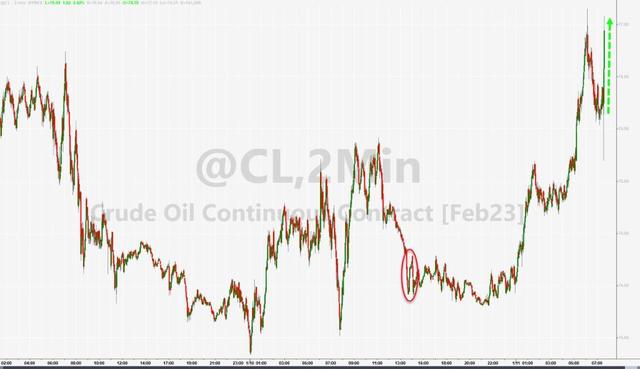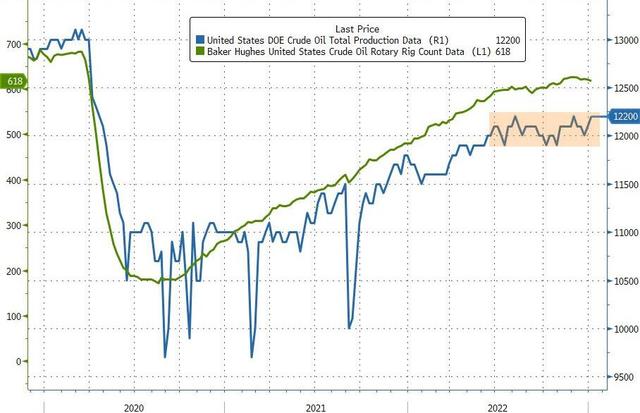U.S. EIA crude oil inventories unexpectedly surged by nearly 19 million barrels last week, the third largest increase in history, and oil prices still rose more than 3% intraday
Source: Wall Street Insights Li Dan
U.S. EIA crude oil inventories increased instead of falling last week, the largest weekly increase since February 2021. The commentary said it reflects the disruption suffered by Gulf of Mexico refiners temporarily shutting down production due to severe cold. After the release of the data, U.S. oil only narrowed its gains in the short-term, and then quickly accelerated upward, rising for the first time in three months for five consecutive days.
U.S. official data showed that U.S. crude oil inventories not only did not fall as expected, but surged last week.
On Wednesday, January 11, Eastern Time, the Energy Information Administration (EIA), a subsidiary of the U.S. Department of Energy, released data showing that,
- In the last week ended January 6, U.S. EIA commercial crude oil inventories increased by 18.961 million barrels from the previous week, the largest weekly increase since February 2021 and the third largest weekly increase on record, while analysts expected a decline of at least About 2.2 million barrels, an increase of 1.694 million barrels in the previous week.
- In Cushing, the main delivery point for U.S. crude oil futures, EIA crude oil inventories increased by 2.511 million barrels last week, the largest weekly increase since December 2021.
- U.S. net crude oil imports increased by 2.71 million barrels per day last week, bringing total net imports to 4.2 million barrels per day, a record high since July 2022. At the same time, last week’s crude oil exports recorded the largest weekly decline since May 2021 .
- Last week, U.S. EIA gasoline inventories increased by 4.11 million barrels month-on-month, analysts expected an increase of 1.2 million to 1.3 million barrels, and a decrease of 300,000 barrels in the previous week.
- Including diesel and heating oil, EIA refined oil inventories fell by 1.069 million barrels last week, compared with analysts’ expectations for an increase or decrease of 500,000 barrels and a decrease of 1.4 million barrels in the previous week.

Usually a large increase in crude oil inventories is a negative signal for crude oil that demand may be weak, but after the EIA data was released this Wednesday, crude oil futures still fluctuated upwards.
In the morning hours of U.S. stocks, the U.S. WTI crude oil futures front-month contract only fell back below $76 in the short term, and then quickly regained $76, and continued to rise. Mid-to-high level, the intraday increase expanded to more than 3%.
Brent crude oil once rose above 82.80 US dollars in midday trading in the US stock market, also hitting a new intraday high since January 3, with an intraday increase of more than 3%. U.S. oil is expected to close for five consecutive trading days for the first time since October 7, 2022, and Brent oil is expected to close for three consecutive days for the first time since December 21, 2022.

The media believe that the surge in U.S. crude oil inventories last week partly reflects the slowdown of refiners to resume production after temporarily shutting down due to severe cold weather. The optimism for the rise in crude oil mainly comes from the adjustment of the epidemic prevention in China, the largest oil importer.
Some comments pointed out that more than 15 million barrels of crude oil in the increase in inventories last week came from the Gulf of Mexico, and most of the increase in inventories was affected by the disruption of refining operations. Last week finally showed such an impact that the previous data did not show. Moreover, last week, the Biden administration released only a small amount of 800,000 barrels from the Strategic Petroleum Reserve (SPR), the smallest weekly release since January 2022.
EIA just released its monthly report on Tuesday, predicting that the combined inventories of gasoline, diesel and aviation fuel will increase by 9% in 2023. In the report, EIA raised its expected US crude oil production in 2023 to a record high of 12.34 million barrels per day. U.S. crude oil production reached 12.2 million barrels per day last week, matching post-pandemic highs.
 Risk Warning and Disclaimer
Risk Warning and DisclaimerMarket risk, the investment need to be cautious. This article does not constitute personal investment advice, nor does it take into account the particular investment objectives, financial situation or needs of individual users. Users should consider whether any opinions, opinions or conclusions expressed herein are applicable to their particular situation. Invest accordingly at your own risk.


Massive information, accurate interpretation, all in the Sina Finance APP
Editor in charge: Zhang Jingdi
